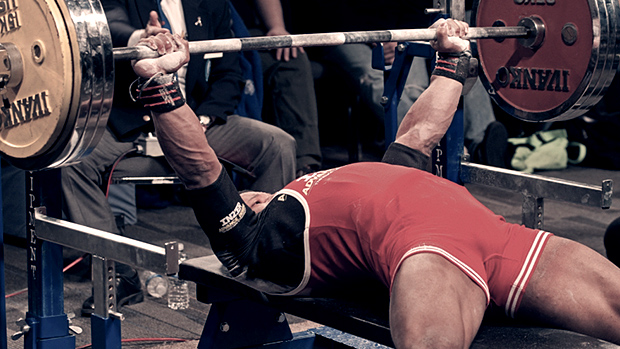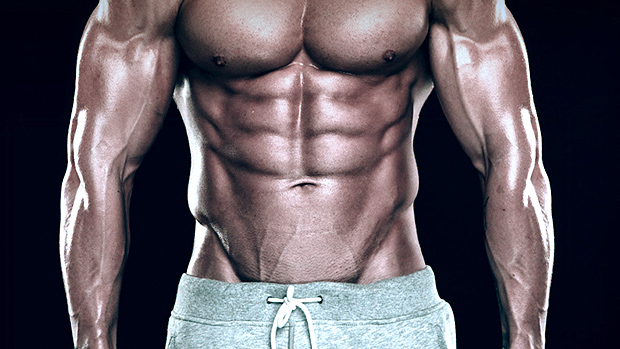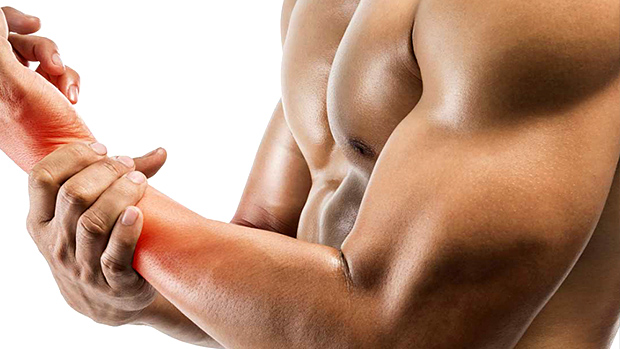Calling Card Quads

Question: Thib, you have some impressive quads! Any secret leg training strategies you'd like to share with us?
I'll let you in on a little secret: my thighs are actually not that big! I'm certainly no match for someone like Tom Platz!
However, in the bodybuilding contests I've entered, I usually end up being the guy with the most impressive quads. They've become my "calling card" over the past few years. So why is it that they look impressive even though they're nothing out of this world in terms of size? The answer is complete development.
While you see some huge quads around, you rarely see a complete upper leg. Many guys have very thick quads with a lot of external development, but they lack inner thigh mass. Others lack outer quad "sweep" which makes even the biggest leg look small as it runs straight up and down like a big wooden log.
Some lifters have inferior vastus medialis development (this is quite common), which makes the quad look too tapered down at the bottom. Finally, many guys (and even more gals) lack quadriceps separation, especially in the middle portion of the muscle group (rectus femoris and sartorius).
Back in my Olympic lifting days, I'd squat 'til the cows came home, then squat some more. During that time my quads were actually much larger than they are now. However, they looked like two big pieces of meat with little form, shape, or detail. They were big, but not really that impressive.
You see, when all you do is one single exercise for the quads (or a few exercises which basically have the same biomechanic action at the knee/hip joint) there's no way you're going to get a full and balanced quadriceps development, unless you're genetically gifted in that department.
The exercise touted as the best quad builder is the squat, and it's an effective exercise. However, as with all other compound movements, your body will always strive to use the muscle or parts of a muscle that are best suited to do the job. Your body isn't after balanced development, but rather survival. All it "knows" when squatting is that a huge load is trying to squash you into the ground, and if you don't lift that load you die!

So in the interest of survival, your body will use the muscle recruitment pattern that'll allow you to lift the load with the greater chance of success/survival. That's why certain persons get great outer quad sweep from squatting while others get more inner thigh or glute development from that same exercise.
What I'm getting at is that you should select exercises that'll put more emphasis on the portion of your quads that's throwing off your balance. It also means that for complete development, you must use a wide array of exercises – not necessarily in the same training phase, but certainly over time.
So without further adieu, here are my favorite exercises to build certain portions of the quads.
The VMO, in my opinion, is the most important portion of the quadriceps complex. It's the teardrop-like muscle on the inside of your thigh, beside your knee. This muscle is crucial for aesthetic purposes as it's very impressive when fully developed, but it's also critical for performance and injury prevention.

The VMO is probably the most important knee extensor during the last few degrees of extension. This means that it's responsible for that final "push" when running or jumping. Weak VMOs will undoubtedly lead to a loss of power application to the ground, even if you can create a lot of it during the initial phase of the knee extension.
Furthermore, the VMO is an active knee stabilizer. As such, if it's strong it can increase knee stability during the practice of your sport. This is especially important in activities where there are frequent changes of direction.
Women athletes especially should pay attention to VMO development because they're at a greater risk of knee injuries due to their pelvic angle ("Q" angle) and laxer ligaments during certain phases of their menstrual cycle (because of the release of elastin).
So what are the best exercises to build up the VMO? My three favorite exercises in that regard are:
1 The Frog Stance Hack Squat


This is also called the Gironda hack slide because Vince Gironda came up with it. To perform it, use the hack squat sled but the following lower body placement and actions:
- Perform the movement with the heels together and while rising on your toes.
- The knees are pushed outward as much as possible during the eccentric (negative) portion of the movement.
- Go back to a straight leg position as you complete the concentric (lifting) portion of the exercise.
2 The Bulgarian Squat
The back leg (non-target leg) is on a bench behind you; the work leg is on the floor in front of you. Go down in a straight line or even slightly backward so that the knee stays above the middle portion of the foot during the entire movement. Go down as low as you can, ideally until the back knee is 1-2" from the floor.
3 The Neutral-and-Out Leg Extension
This is much like a regular leg extension with one slight modification: at the start of the movement your legs are aligned normally (neutral position), but as you lift the weight you rotate your knees outward so that at the end of the movement your feet are pointing 45 degrees outward.
As you go down, slowly get back to the neutral position. A side benefit of this exercise is that it'll also help you build the sartorius muscle.
Vastus lateralis development is also crucial to an impressive upper leg. When this muscle is large it makes the thigh look wide and somewhat round instead of being like two lamp posts: straight up and down.
Good vastus lateralis development also creates the illusion of bigger thighs because it accentuates the contrast between the lower portion of the upper leg and the middle/upper portion (kinda like wide shoulders and wide lats give a better upper body V-shape).
Here are the best exercises to build that portion of the quadriceps:
1 Close-Stance Front Squat

For this movement it's crucial that the trunk/torso remains as straight as possible (as little bending forward as possible) to keep most of the stress on the quadriceps. I prefer the front squat because it's much easier biomechanically to keep a proper torso position than it is with a back squat (in which we all have a tendency to bend forward).
The feet should be neutral (pointing straight ahead) and slightly narrower than the hips. For maximum vastus lateralis development, it's not necessary to go down ass-to-the-grass. Going down to parallel (hips in line with the knees) is sufficient, although I personally prefer to go all the way down.
A little trick for optimal vastus lateralis development is to avoid going up to the full lockout position: squat up until you're 2-3" away from fully extending the legs. This keeps most of the stress on the vastus lateralis portion.
2 Close-Stance Hack Squat

This is a regular hack squat with the feet kept together during the entire movement. Like with the front squat, I recommend stopping just short of the lockout position.
3 The Neutral-and-In Leg Extension
This is similar to the neutral-and-out leg extension explained earlier, but you perform the opposite action. You start with the feet and knees neutral and as you lift the weight you turn the knees inward.
Having a well-built set of rectus femoris muscles can drastically increase the detail in the quadriceps. It creates a deep separation in the middle of the thigh which can have a dramatic effect. A strong set of rectus femoris muscles can also help you perform better, as the rectus femoris (along with the psoas) is one of the main hip flexor muscles.
Hip flexor development has gotten a bad rep in recent years. This is because when this group of muscles is too stiff and tight, it can lead to an hyperlordotic posture and low-back pain. If the hip flexors are super tight it can also reduce your capacity to push the ground away when you run, reducing stride length and power.
Many people advocate not training that muscle group at all. This is a mistake! A strong set of hip flexors can increase running speed by increasing stride frequency. The hip flexors are responsible for bringing the leg back up after you've completed the push-off phase of the running stride. The stronger they are, the quicker you can recoil the leg and initiate a second push-off phase. So for performance purposes, increase hip flexor strength. Just remember to stretch that muscle group to avoid making it too stiff.
The best exercises to build the rectus femoris are:
1 The Sissy Hack Squat

Go down by keeping the hips pushed forward while coming onto your toes. When you lift the weight back up, focus on keeping those hips as high/forward as possible. Basically, this means that during the entire movement the lower back and buttocks are kept off the machine.
2 The Free Sissy Squat

The basic concept for this exercise is the same as with the sissy hack squat: you try to keep the hips as high as possible during the entire movement. To do so, when you go down, focus not on bending the knees, but rather on bringing the knees forward as much as possible.
3 The Power Leg Extension
Ideally, you should use a leg extension station that doesn't have a back support. These are pretty much extinct, so simply put the back support as far away as you can and sit straight, without putting your back on the support.

Now, as you begin to lift the weight I want you to focus on three things:
- Lean back (It's possible that this will mean reaching the back support, but that's okay.)
- Curl your feet toward you so that at the end of the movement your toes are pointing toward your face.
- Try to lift the thighs off the bench. It won't happen, but the simple action of trying to bring the upper leg upward will activate the rectus femoris.
In the dictionary, next to the term "adductor," there should always be a picture of Tom Platz. Platz is without a doubt the owner of the freakiest set of legs ever to grace the stage of a bodybuilding contest. However, it's not so much his quadriceps that set him apart from his competitors, but rather his inner thigh development.
Don't get me wrong, Platz had tremendous vastus lateralis and medialis development, but not drastically more so than some of the other top leg men. No, what made Tom Platz the king of legs was the fullness of his inner thighs. A picture is worth a thousand words, so here's 3000 words for you!

As you can see, his whole thigh development is phenomenal, but what's really freaky is all the meat he carries on the inner portion of his legs. There's just no room for it! Now, I'm not suggesting building up your adductors to the extent of Platz. While impressive, I think it's just too much, and it kinda threw his whole lower body out of balance.
However, I feel that a lack of adductor development really takes away from the look of your legs. Without proper adductor mass, your thighs just won't look full. Men always shy away from doing adductor work because they feel that adductor exercises are girly movements. Well, maybe they are, but so what? If they get the job done and help you build a more complete physique, do them!
Here are a few suggestions:
- Butterfly Squeeze:For this exercise you sit down, feet together and knees pushed out wide. Hold a weight on the inner portion of each knee and squeeze your legs (bringing your knees together).
- Machine Adduction: No need to explain this exercise, simply sit down on the adduction machine and squeeze your legs together. (See, that wasn't too hard, was it?)

You don't need to perform tons of inner thigh exercises because the adductors will get some stimulation from other exercises in your leg program (mostly from the movements targeting the vastus medialis), but adding one of these exercises at the end of your leg program can do you a world of good and help you attain complete lower body development!
Question: Christian, you often say that many people have a hard time building their chest because their triceps take on the bulk of the work in any pressing movement. Well, I'm the exact opposite: my pecs grow very easily but I have almost zero triceps development! Can you help me out?

My triceps have always been a strong point, but that's because I love training them! When I was a teenager starting out in my strength training journey, I remember vividly a big guy at the gym telling me that the triceps were almost two-thirds of the upper arm mass. If I wanted big arms, he said, I should emphasize triceps work.
This left a strong impression on me. To this day I always look for ways of building up my triceps. The basics will work of course, but there are a few tricks I learned that could very well help you correct your problem.
1 Switch to decline triceps work
EMG studies have shown that decline triceps extension work can activate up to 10% more muscle fibers than the same exercises performed on a flat bench. So in that regard, decline dumbbell triceps extensions and decline nosebreakers (barbell extensions) are superior exercises for optimal triceps development.

The decline angle shouldn't be too steep though. A 30 degree decline will be sufficient to get the most out of this exercise. Remember to keep the elbows pointed to the ceiling during the entire exercise.
2 Include close-grip, out-and-in neck presses
This exercise is one of Vince Gironda's favorite triceps builders. It's especially effective at increasing the development of the lateral portion of the triceps (the "fishtail"). It's much like a regular close-grip bench press with a few modifications:
- Hold the bar with the hands 12" apart.
- As you lower the bar, spread the elbows outward (they'll be at around a 45 degree angle from your body). Also, lower the bar to the clavicle/base of the neck, instead of the middle of the chest. This will take the deltoids out of the movement.
- Press the bar above the low portion of your chest while bringing the elbows inward.
3 Include heavy lockout work
This exercise was a favorite of Chuck Sipes, a former Mr.World (1968) who also bench pressed over 530 pounds back when 400 was a huge feat of strength. It was also a favourite of 80's mass monster Tim Belknap.


This exercise is still used widely by powerlifters around the world, including the Westside crew, which collectively has more triceps mass than the rest of the training world combined!

It's pretty straightforward. You place a bench in the power rack and set up the safety pins so that when the bar is resting on them the elbows are at approximately a 135 degree angle. Set up as if you were doing a bench press and press the bar to the lockout position before returning it to the pins. Work your way up to the max amount of weight you can handle for 6-8 reps.
4 Include some isometric lockout work
It's possible that your capacity to recruit your triceps is low. As a result, you can't innervate a lot of the muscle fibers in that muscle group. If that's the case, chances are the fibers you'll have a harder time activating are the fast-twitch fibers which have the greatest growth potential.
Studies have shown that during a maximal isometric action, you can recruit more muscle fibers than during a concentric or eccentric action, and that the added fibers recruited tend to be fast-twitch. So neurally inefficient lifters might want to include some isometric work for the triceps. This is best accomplished by performing the isometric bench press in the high-position (2" short of the lockout).

The set-up is similar to the bench lockout exercise explained earlier, only the bar is under the safety pin and you don't put weight on it. The objective is to press the bar against the safety pins and push as hard as you humanly can. For growth stimulation, I suggest sets of 10-15 seconds, performing 4-6 sets with 30-45 seconds of rest between sets.
That's it for this edition! Hopefully you were able to learn a few tricks to spark new muscle growth. Until next time, keep blasting!




